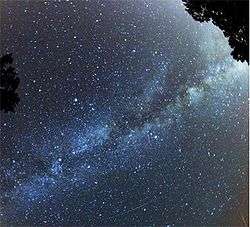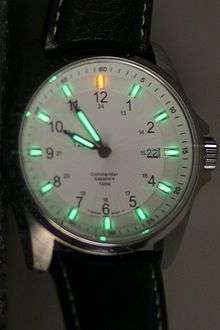List of light sources
[and artificial processes that emit light. This article focuses on sources that produce wavelengths from about 390 to 700 nanometers called visible light.
Electric discharge
- Main article: Electric arc
- Main article: Electrostatic discharge
- Main article: Gas discharge lamp
- Electrodeless lamp
- Excimer lamp
- Fluorescent lamp
- Compact fluorescent lamp
- Tanning lamp
- Black lights
- Geissler tube
- Moore tube (Defunct)
- "Ruhmkorff" lamp (Defunct)
- High-intensity discharge lamp
- Hollow-cathode lamp
- Induction lighting
- Sulfur lamp Sulfur lamps
- Sulfur lamp
- Neon and argon lamps
- Dekatron (Defunct)
 Dekatron
Dekatron - Nixie tube
- Dekatron (Defunct)
- Plasma lamp
- Xenon flash lamp
Optic
- Black-body radiation
- Carbon button lamp (Defunct)
- Earthquake light
- Halogen lamp
- Incandescent light bulb
 Incandescent light bulb
Incandescent light bulb - Lava
- Nernst lamp (Defunct)
- Volcanic eruption
 Volcanic eruption
Volcanic eruption
Combustion
Lamps
- Argand lamp (Defunct)
- Argon flash
- Carbide lamp (Defunct)
- Betty lamp (Defunct)
- Butter lamp
- Flash-lamp (Defunct)
- Gas lighting
- Gas mantle
- Kerosene lamps
- Lanterns
- Limelights (Defunct)
- Oil lamps Oil lamp
- Tilley lamp (Defunct)
Other
- Bunsen burner
- Candle
.jpg) Candle
Candle - Embers
- Explosives
- Fire
 Fire
Fire - Fire whirl
 Fire whirl
Fire whirl - Fireworks
 Fireworks
Fireworks - Flamethrower
- Muzzle flash
- Rubens' tube
- Torch
Nuclear and high-energy particle
- Annihilation
- Bremsstrahlung
- Čerenkov radiation
 Čerenkov radiation
Čerenkov radiation - Cyclotron radiation
- Fusor Fusor
- Nuclear explosion
- Scintillation
- Synchrotron light source
Celestial and atmospheric


Luminescence
Luminescence is emission of light by a substance not resulting from heat.
Chemiluminescence
Chemiluminescence is light resulting from a chemical reaction.
Bioluminescence
Bioluminescence is light resulting from biochemical reaction by a living organism.
- Aequorea victoria
- Antarctic krill
- Cavitation bubbles
- Foxfire
- Glowworm
- Luciferase
- Panellus stipticus
 Bioluminescent panellus stipticus
Bioluminescent panellus stipticus - Parchment worm
- Piddock
Electrochemiluminescence
Electrochemiluminescence is light resulting from electrochemical reaction.
Crystalloluminescence
Crystalloluminescence is light produced during crystallization.
Electroluminescence
Electroluminescence is light resulting of an electric current passed through a substance.
- Light-emitting diodes
- Organic light-emitting diodes
- Polymer light-emitting diodes
- AMOLED
- Light-emitting electrochemical cell
- Electroluminescent wires
- Field-induced polymer electroluminescent
- Laser
 Lasers
Lasers
Cathodoluminescence
Cathodoluminescence is light resulting from a luminescent material being struck by the electrons.
Mechanoluminescence
Mechanoluminescence is light resulting from a mechanical action on a solid.
Triboluminescence, a type of mechanoluminescence, is light generated when bonds in a material are broken when that material is scratched, crushed, or rubbed.
Fractoluminescence, a type of mechanoluminescence, is light generated when bonds in certain crystals are broken by fractures.
Piezoluminescence, a type of mechanoluminescence, is light produced by the action of pressure on certain solids.
Sonoluminescence, a type of mechanoluminescence, is light resulting from imploding bubbles in a liquid when excited by sound.
Photoluminescence
Photoluminescence is light resulting from absorption of photons.
Fluorescence, a type of photoluminescence, is the emission of light by a substance that has absorbed light or other electromagnetic radiation.
Unlike fluorescence, a phosphorescent material does not immediately re-emit the radiation it absorbs.
Radioluminescence

Radioluminescence is light resulting from bombardment by ionizing radiation.
Thermoluminescence
Thermoluminescence is light from the re-emission of absorbed energy when a substance is heated.
Cryoluminescence
Cryoluminescence is the emission of light when an object is cooled.
See also
External links
- A CD spectrometer Color spectrographs of common light sources
- The Double Amici Prism Hand-Held Spectroscope in Practice - Dozens of raw visible spectra of a wide variety of light sources.

